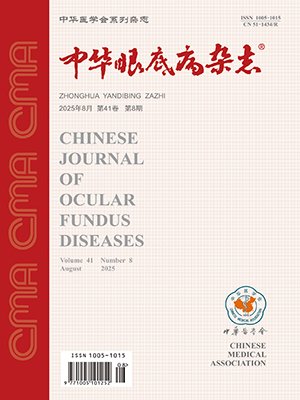| 1. |
Chakravarthy U, Wong TY, Fletcher A, et al. Clinical risk factors for age-related macular degeneration:a systematic review and meta-analysis[J]. BMC Ophthalmol, 2010, 10:31.
|
| 2. |
Ambati J, Ambati BK, Yoo SH, et al. Age-related macular degeneration:etiology, pathogenesis, and therapeutic strategies[J]. Surv Ophthalmol, 2003, 48:257-293.
|
| 3. |
Nagineni CN, Samuel W, Nagineni S, et al. Transforming growth factor-beta induces expression of vascular endothelial growth factor in human retinal pigment epithelial cells:involvement of mitogen-activated protein kinases[J]. J Cell Physiol, 2003, 197:453-462.
|
| 4. |
Lambert V, Lecomte J, Hansen S, et al. Laser-induced choroidal neovascularization model to study age-related macular degeneration in mice[J]. Nat Protoc, 2013, 8:2197-2211.
|
| 5. |
Zhu Y, Lu Q, Shen J, et al. Improvement and optimization of standards for a preclinical animal test model of laser induced choroidal neovascularization. PLoS One, 2014, 9:94743.[2014-04-29] http://www.plosone.org/article/info%3Adoi%2F10.1371%2Fjournal.pone.0094743.
|
| 6. |
Massague J, Blain SW, Lo RS. TGFbeta signaling in growth control, cancer, and heritable disorders[J]. Cell, 2000, 103:295-309.
|
| 7. |
Ogata N, Yamamoto C, Miyashiro M, et al. Expression of transforming growth factor-beta mRNA in experimental choroidal neovascularization[J]. Curr Eye Res, 1997, 16:9-18.
|
| 8. |
Barbara NP, Wrana JL, Letarte M. Endoglin is an accessory protein that interacts with the signaling receptor complex of multiple members of the transforming growth factor-beta superfamily[J]. J Biol Chem, 1999, 274:584-594.
|
| 9. |
Harpel JG, Metz CN, Kojima S, et al. Control of transforming growth factor-beta activity:latency vs. activation[J]. Prog Growth Factor Res, 1992, 4:321-335.
|
| 10. |
Hayashi T, Hideshima T, Nguyen AN, et al. Transforming growth factor beta receptor Ⅰ kinase inhibitor down-regulates cytokine secretion and multiple myeloma cell growth in the bone marrow microenvironment[J]. Clin Cancer Res, 2004, 10:7540-7546.
|
| 11. |
Recalde S, Zarranz-Ventura J, Fernandez-Robredo P, et al. Transforming growth factor-beta inhibition decreases diode laser-induced choroidal neovascularization development in rats:P17 and P144 peptides[J]. Invest Ophthalmol Vis Sci, 2011, 52:7090-7097.
|
| 12. |
Zarranz-Ventura J, Fernandez-Robredo P, Recalde S, et al. Transforming growth factor-beta inhibition reduces progression of early choroidal neovascularization lesions in rats:P17 and P144 peptides. PLoS One, 2013, 8:65434.[2015-05-31]http://www.plosone.org/article/info%3Adoi%2F10.1371%2Fjournal.pone.0065434.
|
| 13. |
Bian ZM, Elner SG, Elner VM. Regulation of VEGF mRNA expression and protein secretion by TGF-beta2 in human retinal pigment epithelial cells[J]. Exp Eye Res, 2007, 84:812-822.
|




